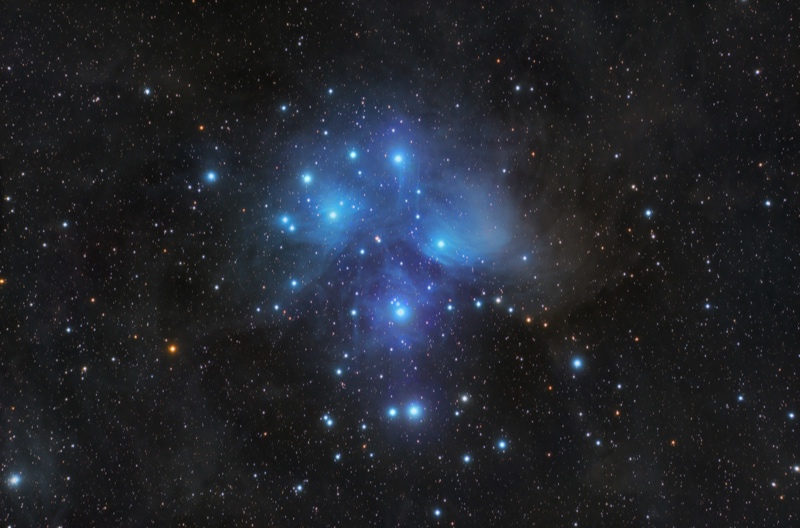
Messier 45, The Pleiades"
About this object
Info about the Pleiades from Sky Safari Pro: The Pleiades are a prominent winter sight in the Northern Hemisphere, and in summer in the Southern Hemisphere. They have been known since antiquity to cultures all around the world, including the Maori (who call them "Matariki") and Australian Aborigines, the Chinese, the Mayans (who called them "Tzab-ek"), the Aztecs ("Tianquiztli"), and the Sioux and Cherokee of North America.
The earliest Greek references to the Pleiades were by Homer in the Iliad and Odyssey, around 750 and 720 B.C., and by Hesiod, about 700 B.C. Some Greek astronomers considered the Pleiades to be a distinct constellation. They are called "Kiymah" in Hebrew, and the Bible refers to them three times - in Job 9:7-9, Job 38:31-33, and Amos 5:8.
The Pleiades are revered in Hindu mythology as Krittika, the six mothers of the war god Skanda, who developed six faces. Some scholars of Islam suggest that the Pleiades ("Al thuraiya" in Arabic) are the Star in Najm which is mentioned in the Quran. Their Persian name is "Soraya", after which the former Iranian empress was named.
In Japan, the Pleiades are named "Subaru". The Japanese automaker derives its name from the cluster, which is represented in its corporate logo.
Old English and German names indicate that the Pleiades were once compared to a "Hen with Chicks". Their modern English name is of Greek origin, though of uncertain etymology. The name "Pleiades" may be derived from the Greek word "plain" for "to sail", or the word "pleios" meaning "full" or "many"; or from "peleiades", meaning "flock of doves".
The Pleiades' name may also be derived from their mythological mother, Pleione, which is also one of its brighter stars. The nine brightest stars of the Pleiades are named for the Seven Sisters of Greek mythology: Sterope, Merope, Electra, Maia, Taygeta, Celaeno, and Alcyone, along with their father Atlas and mother Pleione. As daughters of Atlas, the Hyades were sisters of the Pleiades.
Info about the Pleiades from Sky Safari Pro: The Pleiades are a prominent winter sight in the Northern Hemisphere, and in summer in the Southern Hemisphere. They have been known since antiquity to cultures all around the world, including the Maori (who call them "Matariki") and Australian Aborigines, the Chinese, the Mayans (who called them "Tzab-ek"), the Aztecs ("Tianquiztli"), and the Sioux and Cherokee of North America.
The earliest Greek references to the Pleiades were by Homer in the Iliad and Odyssey, around 750 and 720 B.C., and by Hesiod, about 700 B.C. Some Greek astronomers considered the Pleiades to be a distinct constellation. They are called "Kiymah" in Hebrew, and the Bible refers to them three times - in Job 9:7-9, Job 38:31-33, and Amos 5:8.
The Pleiades are revered in Hindu mythology as Krittika, the six mothers of the war god Skanda, who developed six faces. Some scholars of Islam suggest that the Pleiades ("Al thuraiya" in Arabic) are the Star in Najm which is mentioned in the Quran. Their Persian name is "Soraya", after which the former Iranian empress was named.
In Japan, the Pleiades are named "Subaru". The Japanese automaker derives its name from the cluster, which is represented in its corporate logo.
Old English and German names indicate that the Pleiades were once compared to a "Hen with Chicks". Their modern English name is of Greek origin, though of uncertain etymology. The name "Pleiades" may be derived from the Greek word "plain" for "to sail", or the word "pleios" meaning "full" or "many"; or from "peleiades", meaning "flock of doves".
The Pleiades' name may also be derived from their mythological mother, Pleione, which is also one of its brighter stars. The nine brightest stars of the Pleiades are named for the Seven Sisters of Greek mythology: Sterope, Merope, Electra, Maia, Taygeta, Celaeno, and Alcyone, along with their father Atlas and mother Pleione. As daughters of Atlas, the Hyades were sisters of the Pleiades.
Image Details
- Optics : Stellarvue SV115T Triplet Refractor with a flattener/reducer working at f5.6
- Mount: Mountain Instruments MI-250
- Camera: SBIG STL 11K
- Filters: SBIG Custom Scientific LRGB filter set
- Exposure: LRGB: 100:280:170:280
- Camera/Mount Control: Maxim DL 5.23, CCD Commander
- Processing: PixInsight 1.8 RC7, Photoshop
- Location: Stark Bayou Observatory, Ocean Springs, MS
- Date: Nov 13



